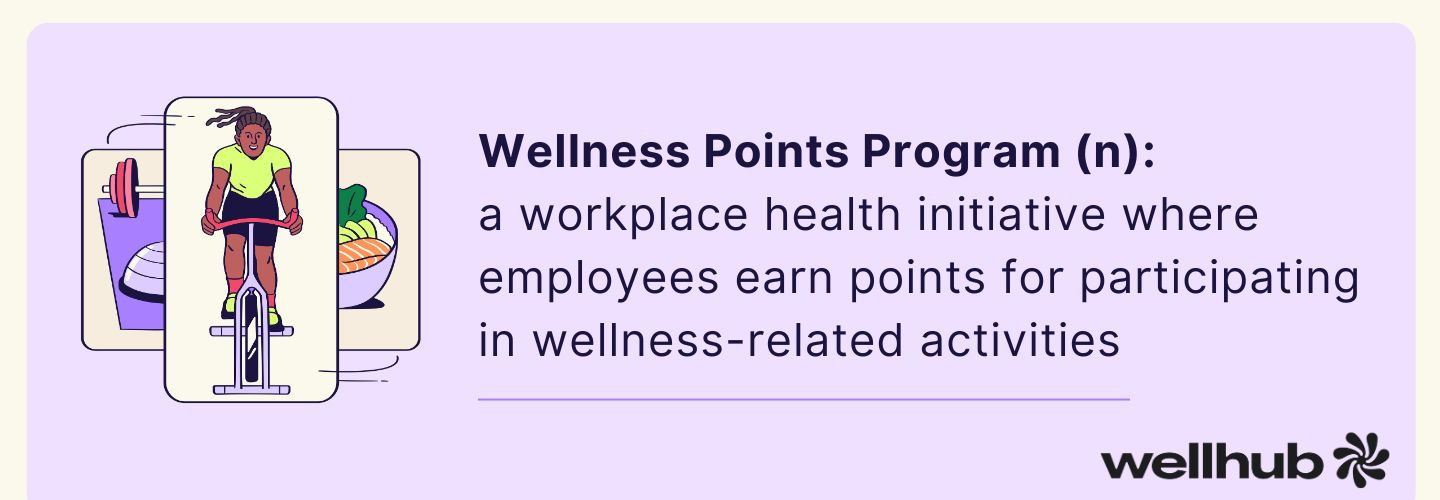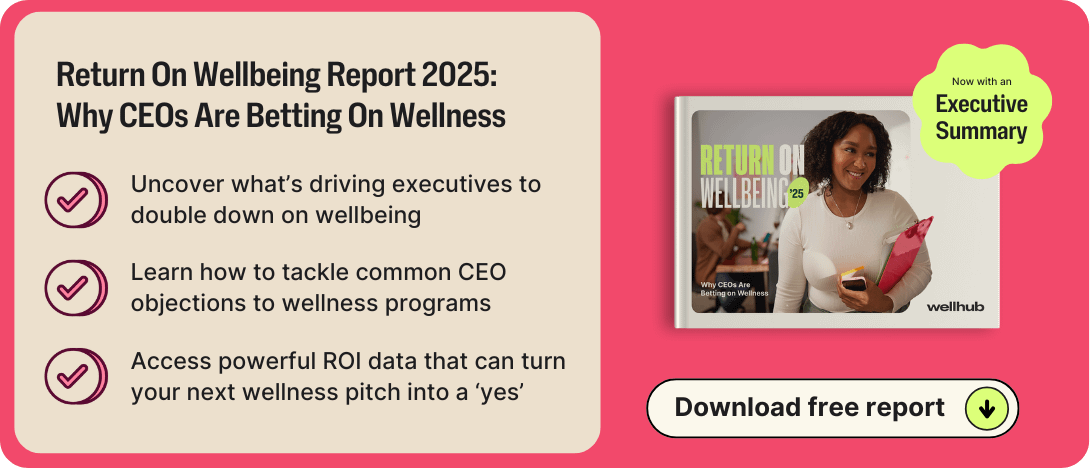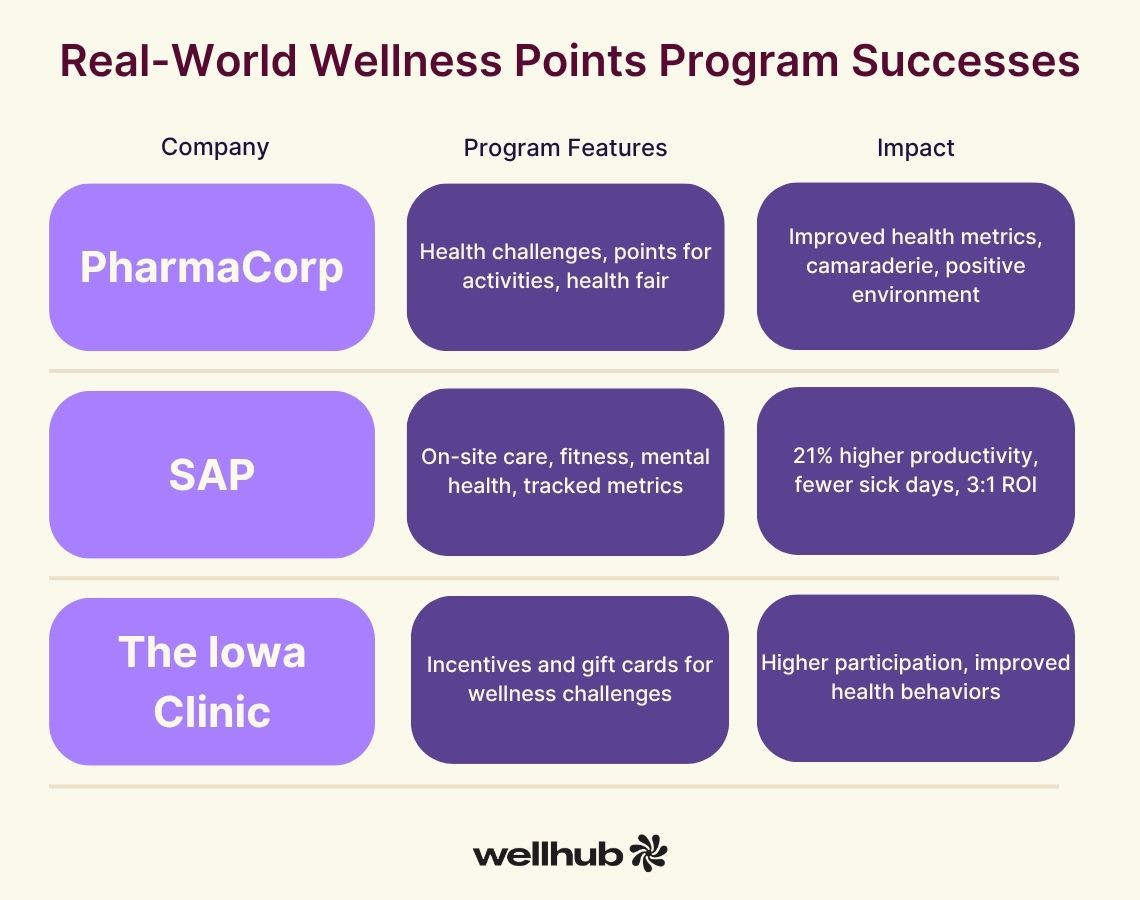Wellness Points Programs: Boost Employee Health & Engagement
Last Updated Nov 13, 2025

Key Takeaways
- A wellness points program turns healthy actions into clear, rewarding steps that help employees build habits that last. It uses structured activities, point tracking, and meaningful incentives to make daily wellbeing choices simple and appealing.
- A strong points-based program supports both employee health and organizational performance through consistent, measurable behavior change. It encourages preventive care, boosts energy, and helps lower healthcare costs while reinforcing a supportive workplace culture.
- Clear goals, diverse activities, and smart reward structures form the foundation of an effective wellness points program. Leaders can guide engagement by choosing activities that fit their workforce, setting point values that feel fair, and offering rewards that motivate without inflating budgets.
- Technology brings wellness programs to life by making participation smooth and social. Mobile apps, wearable integrations, and activity feeds help employees track progress, celebrate wins, and stay connected through shared challenges.
- Real-world examples show that points programs can raise participation, strengthen culture, and improve health outcomes when backed by thoughtful design and steady communication. Organizations that gather feedback, track results, and refine their approach keep the program relevant and valuable year after year.
Generic wellness programs are like New Year’s resolutions — full of good intentions but often forgotten by February. Points programs change this dynamic by turning healthy choices into rewards that keep employees engaged all year long.
It’s like turning wellness into currency at your organization. Just as credit card rewards encourage smart spending, these programs incentivize smart health choices. The result? Employees who actively participate in their wellbeing while building lasting healthy habits.
What is a Wellness Points Program?
A wellness points program transforms healthy activities into rewarding experiences that motivate employees to prioritize their wellbeing. These programs gamify wellness by creating structured ways for employees to earn points by participating in health-promoting activities and reaching wellness milestones.

Think of it like your favorite customer loyalty program, but healthier. Employees earn points for making healthy choices, which they can then exchange for rewards. For example, a program might award points for:
- Daily activities: Employees earn 50 points for logging 10,000 steps, 100 points for tracking healthy meals, and 25 points for completing a meditation session.
- Health assessments: Employees earn 500 points for doing an annual biometric screening and 250 points for quarterly health risk assessments.
- Educational engagement: Employees earn 200 points for attending a wellness workshop and 300 points for completing a health-related online course.
- Preventive care: Employees earn 400 points for an annual physical exam, 200 points for dental cleaning, and 150 points for a flu shot.
Why Implement a Wellness Points Program?
The average cost of health insurance per employee is over $16,000 per year, according to a Mercer survey. Smart companies will look for any possible way to reduce the cost of insurance, and promoting healthy behavior is one of the easiest ways to do so. Let’s see why points-based wellness programs can be a good idea.
Benefits for Employers
A thoughtfully structured wellness points program can create positive changes that ripple throughout your entire organization. Some of the biggest advantages are:
- Increased productivity: When employees participate in regular wellness activities, they bring more energy to their work. The structured nature of points programs encourages consistent healthy habits that boost physical and mental performance. In fact, people who exercise before work are almost 70% more likely to report feeling highly productive at work than those who don’t, according to a 2023 Velotric survey.
- Reduced healthcare costs: Points programs encourage preventative care and proactive health management that can significantly impact an employee's health — and an organization’s bottom line. Organizations with employee wellness programs save an average of $360 per year per employee, according to a study from the American College of Sports Medicine. Incentivizing a healthier workforce can reduce the likelihood of expensive medical conditions.
- Improved employee retention: Companies that demonstrate genuine investment in employee wellbeing create deeper connections with their workforce. More than 90% of workers think their companies should value their wellbeing, according to the American Psychological Association, and a points program is tangible evidence of your organization’s commitment to employee health.
- Enhanced company culture: Wellness initiatives bring employees together around shared goals and experiences. A competitive step challenge can be a surprisingly effective way to build office camaraderie. Plus, even if employees prefer to work out solo, physical exercise has been shown to improve emotional and social wellbeing, according to an article published in the Journal of Modern Medicine.
Benefits for Employees
Organizations that implement wellness points programs create opportunities for employees to thrive both personally and professionally. These programs provide that little extra incentive employees need to do the things they already know are good for them. They can enjoy:
- Improved health and wellbeing: Points systems reward employees who maintain healthy habits. They can build sustainable lifestyle changes that improve their work and personal lives. For example, working out even just once a week can significantly reduce a worker’s stress, according to a 2023 study. If you’ve dealt with stressed-out employees at work, then you already know just how big of a game-changer this can be.
- Motivation to adopt healthy habits: Combining point tracking and rewards provides immediate and long-term motivation for healthy choices. Employees can see their daily progress while working toward meaningful goals — and enjoying rewards along the way. It takes just 21 days for a new habit to stick, according to Scientific American, and the rewards from a points program can be that extra motivation needed during those first three weeks.
- Financial incentives and rewards: Beyond the benefits of better health, points programs offer very real incentives that help offset the initial cost and effort of healthy living. Whether it’s earning gift cards for hitting sleep goals or getting discounts on gym memberships, these rewards make a healthy lifestyle much more palatable at first.
- Increased sense of engagement and community: Points programs create natural opportunities for employees to connect through team challenges and shared achievements. This social aspect makes healthy choices much more enjoyable while building supportive relationships that extend beyond the program itself.
Key Elements of a Successful Wellness Points Program
Creating a wellness points program is like building your dream house. Hard? Definitely, but so worth it in the end! You’ll want to carefully design your blueprint so that you don’t waste any time or resources working on a program that’s shaky at best. These are the elements you’ll need:
Defining Program Goals and Objectives
Before working on your program, it's super important to a clear vision of what success looks like. What are you trying to achieve? Your wellness strategy should directly support both employee wellbeing and organizational success, but you can do this by targeting several things. For example, you could set any of the following objectives:
- Reducing healthcare spending per employee by 5%
- Boosting energy and productivity in the office by 10%
- Reducing the percentage of workers who experience daily stress by 20%
- Increasing participation rates in health workshops to 75%
- Having 90% of employees complete their yearly physical exams
You can start with just one or choose a combination of these. Just make sure your goal is measurable and has a deadline!

Choosing Activities and Assigning Points
The best wellness programs feel less like homework and more like a choose-your-own-adventure story. You can give your employees a diverse set of activities that they can participate in for points, depending on preferences and schedules. Some ideas are:
- Physical fitness initiatives: Getting creative with movement opportunities that work for everyone is always a good idea. You can organize walking meetings for teams to combine work with wellness, launch step challenges that turn daily movement into a friendly competition, and offer virtual fitness classes that suit both in-office and remote employees.
- Mental wellbeing support: Stress management has become one of the most important parts of workplace wellness. Consider providing access to meditation apps, organizing mindfulness workshops, and creating quiet spaces for mental breaks.
- Social connection activities: You can build community through group challenges and team-based competitions. This can include things like wellness book clubs or group workouts before or after work.
- Preventive care rewards: You may make routine health maintenance more appealing by offering substantial point rewards for annual physicals, dental cleanings, vision checks, and health screenings. You could even give bonus points for completing recommended preventive care based on age and risk factors.
Selecting Rewards and Incentives
Although this might sound like the fun part (and it is!), you might want to be careful when choosing what rewards employees have access to through this program. The rewards should be valuable enough that they motivate employees, but not too expensive that they balloon your wellness costs out of control.
Some companies assign a fixed monetary value to each point — for example, 1 point = $1 — making it easy for employees to understand how their wellness efforts translate into real-world rewards. This approach also helps employers budget incentives more predictably.
Different employees will value different rewards, so consider a combination of:
- Extra vacation days
- Wellness spending accounts
- Premium parking spots
- Health savings contributions
- Fitness gear and equipment
- Gift cards for healthy retailers
Leveraging Technology
Your new points-based wellness program needs technology to make participation feel natural and engaging. The right digital tools turn activity tracking from a tedious task into a seamless part of the daily routine.
Your technology platform should serve as a one-stop wellness shop. Look for solutions that offer mobile apps with push notifications for challenges and reminders. These apps should integrate with fitness trackers, smartwatches, and other wearable devices to automatically log steps, exercise, and even sleep patterns.
It’s always a good idea to choose a platform that includes social features like activity feeds where employees can share achievements and cheer each other on. For example, Strava allows users to log activities and share them on an activity feed, where their Strava friends can give “kudos” for each activity.
Real Examples of Wellness Points Programs

PharmaCorp
Background: PharmaCorp, a global pharmaceutical company with over 5,000 employees, faced rising healthcare costs and noticed a trend of increasing absenteeism and low morale. Leadership wanted a solution that would not only improve employee health but also foster a sense of community.
Program Design: PharmaCorp launched a points-based wellness program called “Wellness Wins.” Employees could earn points for:
- Completing annual health screenings
- Participating in step-count challenges
- Attending nutrition and mental health seminars
- Logging healthy habits in a mobile app
Points were tracked via a user-friendly digital portal. Employees could redeem their points for rewards such as fitness trackers, extra vacation hours, or charitable donations.
Implementation: The program kicked off with a company-wide health fair, where employees could register, get baseline health checks, and join teams for the first step challenge. Monthly wellness themes (e.g., Heart Health Month, Stress Awareness) kept the program fresh and engaging.
Impact:
- Participation: 78% of employees engaged in at least one wellness activity in the first year.
- Health Outcomes: The company saw a 12% reduction in employees with high blood pressure and a 9% drop in reported stress levels.
- Culture: Team-based challenges fostered camaraderie and cross-departmental relationships.
- Business Results: PharmaCorp reported a 15% decrease in sick days and a measurable reduction in healthcare claims.
Key Takeaway: A points-based program, when tied to meaningful rewards and team activities, can drive both health improvements and a stronger workplace culture.
SAP
Background: SAP, a leading enterprise software company, employs more than 100,000 people worldwide. With a diverse and distributed workforce, SAP sought to unify its approach to employee well-being.
Program Design: SAP’s “Global Health and Well-Being” initiative included a robust points-based platform. Employees could earn points for:
- Using on-site fitness centers or virtual workout classes
- Completing annual physicals and health risk assessments
- Participating in mindfulness and resilience workshops
- Engaging in company-wide step-count competitions
Points were tracked via a global digital platform, and employees could redeem them for wellness-related merchandise, charitable giving, or extra vacation days.
Implementation: SAP’s program was supported by executive leadership and integrated into the company’s overall performance and engagement strategy. Regular communications, local wellness champions, and data analytics ensured high visibility and continuous improvement.
Impact:
- Productivity: Employees in the program reported 21% higher productivity.
- Absenteeism: There was a significant reduction in sick days and lost work hours.
- ROI: SAP calculated a 3:1 return on investment, factoring in healthcare savings and productivity gains.
- Wellbeing: Employee engagement scores and reported well-being improved year over year.
Key Takeaway: A data-driven, globally consistent wellness points program, with strong leadership support, can deliver measurable business results and improve employee well-being at scale.
The Iowa Clinic
Background: The Iowa Clinic, a large independent medical group, wanted to set an example for its patients by promoting health and wellness among its 1,000+ employees.
Program Design: The clinic introduced a points-based wellness program where employees could earn points for:
- Completing biometric screenings and flu shots
- Participating in walking or weight-loss challenges
- Attending health education seminars
- Logging healthy meals or exercise in a wellness portal
Points could be redeemed for gift cards, fitness equipment, or contributions to health savings accounts.
Implementation: The clinic used a third-party wellness platform to track points and participation. Departmental competitions and regular communications helped maintain momentum throughout the year.
Impact:
- Participation: More than 80% of employees took part in at least one wellness activity.
- Health Behaviors: There was a marked increase in physical activity and preventive care visits.
- Culture: Employees reported feeling more connected and supported by their employer.
Key Takeaway: Healthcare organizations can lead by example with well-structured, incentive-based wellness programs that drive high participation and meaningful health improvements.
Key Case Study Takeaways
- Tailor programs to your unique workforce needs.
- Make rewards meaningful and accessible.
- Leverage data to track impact and refine your approach.
- Foster a sense of community through team-based challenges.
- Secure leadership buy-in for lasting success.
Common Wellness Point Program Challenges and How to Overcome Them
Even well-designed wellness points programs face obstacles. Understanding common challenges can help you prepare effective solutions before you run into any of them.
| Challenge | Solution |
|---|---|
| Low Participation Rates | Some employees may feel overwhelmed by program requirements or skeptical about sharing health information. Start simple! Use easily achievable activities and clearly communicate privacy protections to build trust and momentum. |
| Engagement Sustainability | Keep interest high by regularly introducing new challenges, refreshing reward options, and celebrating success stories. Interdepartmental competitions (e.g., marketing vs. accounting) can also fuel enthusiasm and participation. |
| Technology Barriers | Offer multiple ways to log activities, including manual tracking if possible. If not, support employees with training sessions and clear instructions to ensure everyone understands how to join in. |
| Budget Limitations | Use cost-effective rewards like extra paid time off or priority parking. Partnering with local health businesses for free or discounted services can expand your reward offerings without straining the budget. |
Implementing a Wellness Points Program, Step-by-Step
Let’s make it happen! Now that you’ve outlined your goals and learned about the potential of points-based wellness programs, it’s time to roll up your sleeves and dive into implementation. Here’s a clear, actionable roadmap to get your program up and running.
Step 1: Assess your Organization’s Needs
Your employees’ wellness aspirations are your North Star. Start by surveying them to understand their interests and barriers. Dive into health trends and costs to pinpoint areas where a wellness points program can truly shine.
Step 2: Design Program Structure
This is where the magic begins. Assign point values to wellness activities and set milestones for rewards. Ensure your structure reflects your program’s ultimate goals—whether it’s boosting participation, enhancing mental wellness, or trimming healthcare costs.
Step 3: Choose Your Tech
A user-friendly platform can make or break your program. Select a solution that balances functionality with ease of use, and test it thoroughly before launch. A seamless experience ensures everyone can join in without a hitch.
Step 4: Develop a Communication Strategy
Excitement starts with a plan. Craft compelling materials—emails, posters, videos—that showcase the benefits of the program. Keep your messaging clear and engaging, so employees know exactly how to get started and why it matters.

Step 5: Train Program Administrators
Equip your HR team and wellness champions with the tools and knowledge they need. Provide clear guidelines on reward distribution to keep things fair and drama-free.
Step 6: Launch a Pilot Program
Kick things off with a pilot group to test your program in action. Use their feedback to tweak and refine before you go full-scale. Think of it as your dress rehearsal for success.
Step 7: Monitor and Adjust
Track participation, engagement, and feedback. Be ready to adapt as you go—your team’s insights are the secret sauce to keeping the program relevant and impactful.
Step 8: Scale and Expand
Once the program is humming along, consider adding new activities or rewards. You might even include employees’ family members to foster a community-wide culture of wellness.
Improve Your Team’s Health with an Effective Wellness Program
Generic wellness initiatives often fail to sustain long-term engagement. A wellness points program transforms this approach by incentivizing health-promoting behaviors, empowering employees to prioritize their wellbeing while earning meaningful rewards.
Investing in such programs directly impacts business success. Companies with effective wellness programs see 91% of HR leaders reporting reduced healthcare costs and 99% noting increased productivity. Beyond cost savings, these programs build a culture of wellness, driving employee satisfaction and retention.
Speak with a Wellhub Wellbeing Specialist to deliver a wellness program that drives engagement and delivers measurable results!

Company healthcare costs drop by up to 35% with Wellhub*
See how we can help you reduce your healthcare spending.
You May Also Like:
- A Generational Guide to What Workers Want — and How to Deliver
- Benefits of an Employee Wellness Program
- Employee Wellness Programs: Boost Productivity & Cut Costs
References:
- American College of Sports Medicine. (2024). ACSM Blog. ACSM_CMS. https://www.acsm.org/blog-detail/fitness-index-blog/2024/06/12/economic-benefits-of-workplace-wellness-programs-and-changes-since-covid-19
- American Psychological Association. (2023). 2023 work in America survey. Apa.org; American Psychological Association. https://www.apa.org/pubs/reports/work-in-america/2023-workplace-health-well-being
- Mercer. (n.d.). National Survey of Employer-Sponsored Health Plans. Www.mercer.com. https://www.mercer.com/en-us/solutions/health-and-benefits/research/national-survey-of-employer-sponsored-health-plans/
- Solis-Moreira, J. (2024, January 24). How Long Does It Really Take to Form a Habit? Scientific American. https://www.scientificamerican.com/article/how-long-does-it-really-take-to-form-a-habit/
- Szarek, S., Edyta Bombiak, & Aneta Wysokińska. (2024). The Role of Physical Activity in the Improvement of Well-being — the Case of University Staff. Journal of Modern Science, 56(2), 263–284. https://doi.org/10.13166/jms/188741
- Velotric. (2023, August 7). Night vs. Morning Workouts: Does Timing Matter? Velotric. https://www.velotricbike.com/blogs/story-landing/night-vs-morning-workouts-does-timing-matter
- Yoon, E. S., So, W.-Y., & Jang, S. (2023). Association between Perceived Psychological Stress and Exercise Behaviors: A Cross-Sectional Study Using the Survey of National Physical Fitness. ProQuest, 13(10), 2059. https://doi.org/10.3390/life13102059
Category
Share

The Wellhub Editorial Team empowers HR leaders to support worker wellbeing. Our original research, trend analyses, and helpful how-tos provide the tools they need to improve workforce wellness in today's fast-shifting professional landscape.
Subscribe
Our weekly newsletter is your source of education and inspiration to help you create a corporate wellness program that actually matters.
Subscribe
Our weekly newsletter is your source of education and inspiration to help you create a corporate wellness program that actually matters.
You May Also Like

Corporate Wellness Trends HR Must Know for 2026 | Wellhub
See the top 2026 wellness trends shaping performance, retention, and culture—plus how HR can build a unified, ROI-driven wellbeing strategy.

Employee Financial Wellness Programs: Ultimate HR Guide | Wellhub
Create an effective financial wellness program that supports your employees in their financial needs, boosting productivity and retention.

6 Ways to Mental Health Support at Work | Wellhub
Transform your workplace with effective mental health support strategies to reduce stress, prevent burnout, and create a thriving company culture.